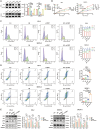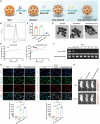Quercetin combined with shTERT induces apoptosis in ovarian cancer via the P53/Bax pathway, and RGD-MSN/QR/shTERT nanoparticles enhance the therapeutic efficacy
- PMID: 40696430
- PMCID: PMC12285142
- DOI: 10.1186/s12951-025-03546-0
Quercetin combined with shTERT induces apoptosis in ovarian cancer via the P53/Bax pathway, and RGD-MSN/QR/shTERT nanoparticles enhance the therapeutic efficacy
Abstract
Background: Ovarian cancer (OC) is a highly malignant gynecological tumor with poor current treatment effects. Telomerase reverse transcriptase (TERT) is an important component of telomerase and plays an important role in the progression of ovarian cancer. Quercetin(QR) has been shown to inhibit the cell cycle and induce the apoptosis in various types of tumors. However, the mechanism of quercetin in ovarian cancer and whether it can be applied in the treatment of ovarian cancer has not been fully understood.
Results: OC cells were intervened with QR in vitro and it was found that QR only inhibited the cell cycle but not induced cell apoptosis. By conducting network pharmacology, proteomics and TCGA-OV database analysis, we found that QR inhibited the cell cycle by binding to P53 and P21. However, in this study, overexpressed TERT in OC could bind to P53 and inhibit the binding of QR to P53, failing to induce tumor cell apoptosis. After TERT was knocked down, QR significantly suppressed the cell cycle of OC cells and induced apoptosis.To realize high drug delivery efficiency and drug targeting to improve the effect of inhibiting OC, we designed and prepared RGD-MSN/QR/shTERT nanoparticles for the combined administration of QR and shTERT. As confirmed by the in vivo experiments, RGD-MSN/QR/shTERT possessed good targeting ability and significant OC inhibiting effect, with no adverse reactions, and improved the survival benefits.
Conclusions: This study demonstrated the mechanistic and therapeutic advantages of combining QR with shTERT in the treatment of OC. Based on this mechanism, we synthesized the novel nanoparticles (RGD-MSN/QR/shTERT) and verified the favorable OC inhibiting effect in vivo, providing a novel strategy for the treatment of OC.
Keywords: Nanoparticle; Ovarian cancer; P53; Quercetin; TERT.
© 2025. The Author(s).
Conflict of interest statement
Declarations. Ethics approval and consent to participate: All animal experiments complied with the ARRIVE guidelines and were carried out in accordance with the National Research Council’s Guide for the Care and Use of Laboratory Animals. The animal experimental protocols in this study were approved by the Huachuang Sino Animal Experiment Ethics Committee (SK23035-P001-01). Consent for publication: Not applicable. Competing interests: The authors declare no competing interests.
Figures







Similar articles
-
A rapid and systematic review of the clinical effectiveness and cost-effectiveness of topotecan for ovarian cancer.Health Technol Assess. 2001;5(28):1-110. doi: 10.3310/hta5280. Health Technol Assess. 2001. PMID: 11701100
-
[The effect of miR-3591-3p targeting P53 on cisplatin resistance in ovarian cancer SKOV3/DDP cells].Zhonghua Zhong Liu Za Zhi. 2025 Jun 23;47(6):498-507. doi: 10.3760/cma.j.cn112152-20240711-00285. Zhonghua Zhong Liu Za Zhi. 2025. PMID: 40534265 Chinese.
-
Systemic treatments for metastatic cutaneous melanoma.Cochrane Database Syst Rev. 2018 Feb 6;2(2):CD011123. doi: 10.1002/14651858.CD011123.pub2. Cochrane Database Syst Rev. 2018. PMID: 29405038 Free PMC article.
-
The efficacy of combination therapy using adeno-associated virus-TRAIL targeting to telomerase activity and cisplatin in a mice model of hepatocellular carcinoma.J Cancer Res Clin Oncol. 2010 Dec;136(12):1827-37. doi: 10.1007/s00432-010-0841-8. Epub 2010 Mar 7. J Cancer Res Clin Oncol. 2010. PMID: 20213096 Free PMC article.
-
Targeting PNPO to suppress tumor growth via inhibiting autophagic flux and to reverse paclitaxel resistance in ovarian cancer.Apoptosis. 2024 Oct;29(9-10):1546-1563. doi: 10.1007/s10495-024-01956-3. Epub 2024 Apr 13. Apoptosis. 2024. PMID: 38615082 Free PMC article.
References
-
- Bray F, Laversanne M, Sung H, Ferlay J, Siegel RL, Soerjomataram I, Jemal A. Global cancer statistics 2022: GLOBOCAN estimates of incidence and mortality worldwide for 36 cancers in 185 countries. CA Cancer J Clin. 2024;74(3):229–63. - PubMed
-
- Hinchcliff E, Westin SN, Herzog TJ. State of the science: contemporary front-line treatment of advanced ovarian cancer. Gynecol Oncol. 2022;166(1):18–24. - PubMed
-
- Zapardiel I, Diestro MD, Aletti G. Conservative treatment of early stage ovarian cancer: oncological and fertility outcomes. Eur J Surg Oncol. 2014;40(4):387–93. - PubMed
-
- Cianciosi D, Varela-Lopez A, Forbes-Hernandez TY, Gasparrini M, Afrin S, Reboredo-Rodriguez P, Zhang J, Quiles JL, Nabavi SF, Battino M, et al. Targeting molecular pathways in cancer stem cells by natural bioactive compounds. Pharmacol Res. 2018;135:150–65. - PubMed
MeSH terms
Substances
Grants and funding
LinkOut - more resources
Full Text Sources
Medical
Research Materials
Miscellaneous

